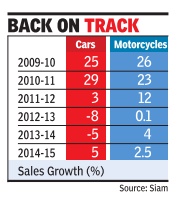Automobile industry: India
This is a collection of articles archived for the excellence of their content. |
Average age of cars on road
Transport min says ban unfair on owners
Dipak Dash The Times of India Dec 03 2014
The findings of a study by IIT (Delhi) for UN Environment Programme showed that on average, less than one percent cars which are over 15 years old are plying on Delhi roads. The findings were same for two-wheelers. The findings were based on vehicles reporting at fuel stations and pollution checking centres. While the sample size for cars was 2,231, it was 1,570 in the case of two-wheelers. The survey found that the average age of cars on road was 4.4 years and the average age of two-wheelers was 4.7 years.
The study also covered two other cities Visakhapatnam and Rajkot and the findings were not much different.
Referring to a study conducted by central roads research institute (CRRI) in 2007, the report has mentioned how the vehicle registration date in Indian cities is an overestimation of the actual number of vehicles plying. This is because private vehicle owners pay a life time tax on the purchase of the vehicle and don't have to register their vehicle annually .
Number of vehicles:city-wise

Automobile sales: 2009-15

Apr 11 2015
Pankaj Doval
Car sales up after 2 yrs of decline
After two successive years of decline, car sales registered a 5% growth in the last financial year (2014-15). But the revival may not be sustained in the current financial year due to an adverse impact on the rural economy after unseasonal rains. Car sales fell 5% in 2013-14 and 8% in 2012-13 as high interest rates and growing fuel prices had dampened buyer sentiment.
The car industry has started showing some positive traction after entry of the Narendra Modi government in May last year. Modi's entry , which revived hopes of an economic turnaround, also coincided with a cut in fuel prices and a marginal reduction in interest rates. These positive factors, coupled with a low base year, led to a growth in sales numbers.
But a weak rural economy may play spoilsport. The difficult journey of the rural economy started last year with a deficient monsoon. This year also, unseasonal rains have damaged rabi crops.
The impact of an affected rural economy is already visible on the sales of motorcy cles, which grew only 2.5% in 2014-15, lagging a 25% growth witnessed by scooters. Sales of bikes fell 6% during the last quarter of 2014-15. Analysts said with rural economy playing an increasingly bigger role in the sales of small cars and motorcycles, an adverse demand impact here could hit the overall sales momentum.
“We are already feeling the pressure of a slowdown in the rural economy ,“ Vishnu Mathur, DG of industry body Society of Indian Automobile Manufacturers (Siam), told TOI.“Sales in the rural regions are critical for growth in some of the important categories, especially motorcycles.“
According to some estimates, rural economy accounts for around 30% to total sales of car makers -especially in case of mass-market manufactur ers like Maruti and Hyundai, while in motorcycles, the share has reached nearly half.
“Market sentiment in some rural areas has been impacted due to various factors, including the curtailment of national rural employment guarantee act (NREGA) spends, poor crop realisation and moderating wages,“ an official at top twowheeler maker Hero MotoCorp said. “The industry has, therefore, felt some impact in retail off-take in markets such as Bihar and Madhya Pradesh and sugar cane-growing areas in Uttar Pradesh and Maharashtra.“
The scooter category , however, is somewhat insulated from the agri pressure as it has abig share of the urban market.
The weak trends in rural India are worrisome for car manufacturers, which had turned their focus on agri-led regions.
